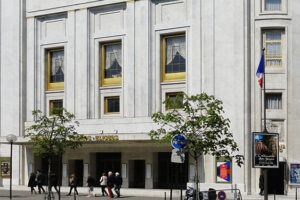

Bel Canto at Caramoor has defied many a sultry day (and a couple of stormy ones) to give pleasure to fans of obscure opera (Ciro in Babilonia, La fille d’un exilé, Maria di Rohan, Aureliano in Palmira) and alternative versions of some less obscure ones (La forza del destino, Les Vêpres Siciliennes, La favorite). The program has also boosted the careers of such young singers as Vivica Genaux and Michael Spyres, besides offering unusual vehicles to veterans like Ewa Podles and Hei-kyung Hong. One singer who has enjoyed particular success here is Angela Meade, whose first Norma and Semiramide were Caramoor occasions. This time, Il Pirata featured Ms. Meade in her first Imogene, a role associated with Callas, Caballé and Renée Fleming.
With Il Pirata (The Pirate), in 1827, Bellini’s name was first heard outside of Italy. It was also the first opera Bellini set to a text by the learned classicist Felice Romani. Bellini claimed that Romani’s rich vocabulary inspired his melodies, and Maestro Crutchfield, in prefatory remarks, suggested that Romani appealed to a psychologically intense, otherworldly strain in the composer, though one wonders why his libretti for Donizetti and Mercadante did not inspire similar creations on their part.
This is the only Bellini opera set in his native Sicily, but the story is internationally romanticist, the tale (derived from an Irish play) of a Byronic self-tormented, self-destructive hero, the very essence of early romanticism.
The pirate, Gualtiero, has been separated from his true love, Imogene, by the (endless) wars of the Sicilian Succession, and in his ten years’ absence, she has been forced to marry his archenemy, Ernesto, by whom she has had a son. Then Gualtiero turns up, shipwrecked. Imogene’s emotions are divided, and she spends far too long trying to keep the men from figuring the situation out. When they know, as she fears, they fight a duel. Ernesto loses. The local soldiery, who work for him, naturally want Gualtiero dead, too. Imogene goes mad. Why not? No romantic heroines had yet chosen this way out of a predicament, but the coloratura mad scene soon became as popular as sliced pizza. It is the female equivalent of Byron’s heroes’ usual suicide.
In Romani’s original libretto, by the way, the finale went, as expected, to the title character, Gualtiero the Pirate, who, after an appropriately ornamental cabaletta, killed himself to escape execution. Bellini set this brief scene but authorities differ on whether or not it was ever performed—according to Herbert Weinstock’s biography, the music was probably used, at least at the premiere. And all this came after Imogene went mad. This seems absurd to us, but Donizetti used just such a conclusion for his Lucia a few years down the road, mad scene of soprano followed by tenor suicide, and though there has been grumbling by soprano fans eager to cheer and go home, Lucia has held the stage securely for nearly two hundred years. It may not work, but it works.
In any case, for the premiere or not long after it, someone (very likely the first Imogene, Henriette Méric-Lalande, a lady able to stare down any composer) persuaded Bellini to conclude the opera with an extended Mad Scene and allow Gualtiero to languish, condemned, offstage. Don’t ask why Giovanni Battista Rubini, the very first Italian superstar tenor, put up with that—perhaps he was exhausted after a long night. (Critics say he had a small voice, even for that day and age.) The change proved to be Pirata’s blessing and curse—the Mad Scene, recorded by a dozen divas, is by far the best-known part of the score.
Angela Meade, returning to Caramoor, where she has often triumphed, remains a puzzle. The many beauties of which her voice is capable have made bel canto fans hopeful, but the flaws in the both the instrument and her technique have proved intractable, if indeed she has recognized and addressed them. It is difficult, at times, to tell if she is a high coloratura with an unstable mid-voice and an untameably wide vibrato (such that pitch is often indefinite or simply flat) or if she possesses a very beautiful and well-grounded spinto with a detached head voice that never seems to bridge the gap.
When she is good, she can be very good indeed; when she’s bad, she’s all over the place. Her dramatic instincts are sometimes excellent—there were declamatory passages in Il Pirata of startling beauty and effect—while at other times she drifts in her sleep. We never know which Meade we’re going to get.
Her opening scene and aria in Il Pirata last Saturday were a case in point: indefinite pitch, awkward phrases, lofty lines that were very pretty but might have been floating in from the next room. But the entrance of Imogene’s brutal Ernesto (Harold Wilson, a virile, growling bass with energy and flavor) seemed to set her back up, to make her angry. Anger suits Meade better than languor. When she fought back, her voice was bright, clear and on pitch, and her acting made us all sit up. The concertato that concludes Act I evinced splendid work from everybody.
The tenor was Santiago Ballerini, an Argentine last heard here in La favorite, where he was no match for Clémentine Margaine’s throbbing Léonore. The voice still seems a size too small but it is such a pretty instrument, so smooth and clear in Bellini’s grateful lines, with a not-uncreditable attempt at an E-flat in head voice (a Rubini specialty), that Caramoor was very happy with him, even when Meade or Wilson swamped him in duet. His second aria, too, included highly attractive if not quite star-quality fioritura.
The Mad Scene was Meade’s great moment. All of us with other divas in our ears—my first Imogene was gutsy Marie Traficante, a performance that burned the stage—anyone else remember her? Meade was undaunted, uneven but riveting, with some spread in the notes. Her leaps to the sky did not seem freakish, as they have done in the past; they seemed part of the unstable mind she was portraying. It was a satisfying conclusion, far more in character than, say, Fleming’s swoopy efforts at the Met or even Olga Makarina’s better one.
Among the able supporting cast, I was especially impressed by every phrase sung by Robyn Marie Lamp as Imogene’s confidante. The voice is robust, easily produced, golden but warm rather than metallic. I’d love to hear how she’d surge through a bel canto cavatina, but her next role is Ariadne. Keep your ears peeled.
The chorus and the Orchestra of St. Luke’s were led by Maestro Crutchfield with a lively, swift-paced hand that brought the evening’s preposterous catastrophes too soon to worry how little sense they made. The performance effaced memories of the tedium of the Met production under a dramatically challenged Bruno Campanella.
The afternoon’s pre-event appetizers were choice. Except that so much of it is comparison of recordings and piano illustrations, I’d wish Crutchfield would put his superb explanation of Bellini’s influence on Chopin, Verdi and, above all, Wagner on paper or tape. I hope he will create a podcast to be replayed, memorized, spread far and wide as it deserves. (One friend claimed he heard echoes of Wagner throughout Il Pirata, which can’t have been the maestro’s intent.)
After one final concert of the program, Rossini’s Petite Messe Solenelle on July 23, the maestro and his caboodle move next year to Purchase, just down the road, with Mayr’s Medea in Corinto.
Photo: Gabe Palacio
























Comments